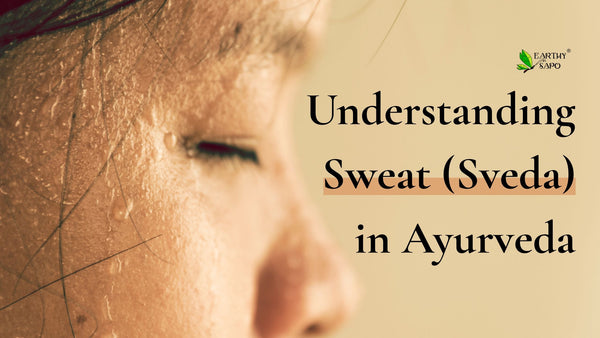Understanding Sweat (Sveda) in Ayurveda: Functions, Channels & Imbalances

In Ayurveda, sweat is known as Sveda. It is one of the three main waste products (mala) of the body alongside urine and stools. Sweating (Svedana) is the process of excreting toxins from the body through skin pores in the form of sweat.
As per Ayurveda, sweat is a by-product (mala) of fat metabolism. While the main function of fat tissue (meda dhatu) is to store energy and lubricate the body, its metabolism produces sweat as a waste product.
Sweat is also one of the sites (ashraya) where Pitta resides. Since Pitta governs heat and metabolism, it plays a big role in when and how much we sweat.
Sweat Channels (Svedavaha Srotas)
The channels or pathways through which sweat is formed and transported are called Svedavaha Srotas. Their primary origins are the adipose tissue (Meda Dhatu) and hair follicles (Romakoopa). In other words sweat channels begin in the fat tissue exit through pores at the base of hair follicles.
Contamination of these channels can lead to disorders like excessive sweating or absence of sweating, roughness or overly moist skin, or burning sensation. Some of the possible causes of contamination include excessive physical exercise, prolonged exposure to heat or sunlight, unhealthy eating habits (intake of both hot and cold things simultaneously), or even intense emotions like anger or fear.
Functions of Sweat (Sveda):
-
Thermoregulation (maintaining body temperature) - Sweat is the main mechanism for cooling the body and releasing excess metabolic heat. Pitta governs this heat, and sweat acts as its outlet.
-
Moisturizing & Softening the Skin (Kledha Vridhi, Saukumarya Kriya) - Sweat maintains the softness, elasticity, and suppleness of the skin through natural moisture (kledha).
-
Eliminating Water-Soluble Toxins - Sweat removes waste products formed during metabolism, especially from Meda Dhatu (fat tissue) and Rasa Dhatu (plasma/primary nutrient fluid).
Sweating Disorders in Ayurveda (Sveda Vikriti):
Ati-sveda (Excessive sweating)
Perspiration more than normal, even without heat, exertion, or emotional triggers. This can be caused due to:
- Contamination of Svedavaha Srotas
- Medo Adhikya (excess of fat / obesity)
- Aggravated Pitta dosha
Excessive sweating can cause foul smell or excessive body odour (Daurgandhya) and itching (Kandu).
A-sveda (Absence or lack of sweating
Little to no sweat production, even in conditions that normally cause sweating. This can be caused due to:
- Contamination of Svedavaha Srotas
- Dehydration
- Vitiation of Vata dosha (dryness, constriction of channels)
- Nervous system disorders
Symptoms include dryness, cracking of skin (Twak Paripatana), skin disorders (Twak Dosha), altered tactile sensation (Sparsha Vaigunya), scaling of skin (Twak Sphootana) and falling of body hair (Romachyuti)
Durgandha-sveda (Foul-smelling sweat)
This can be due to:
- Aggravated of Pitta — Excess body heat from spicy food, alcohol, emotional stress, or hot climate can impart a strong, sour, or acrid smell to sweat.
- Kapha imbalance – Conditions like obesity and diabetes can make sweat stale and musty.
- Hormonal issues - Puberty, menopause, or thyroid imbalance may alter sweat odor.
- Ama accumulation (toxins build up) - Poor digestion, incompatible foods or sluggish metabolism can produce foul smelling sweat.
- Lifestyle factors - Diet rich in garlic, onion, alcohol, fermented foods and caffeine or lack of exercise can cause sweat to have a bad odor.
- Poor hygiene or skin disorders - Sweat mixing with bacteria, dead skin, or sebum.
- Contamination of Svedavaha Srotas (sweat channels)- Blockage or impurity in the body’s sweat pathways.










